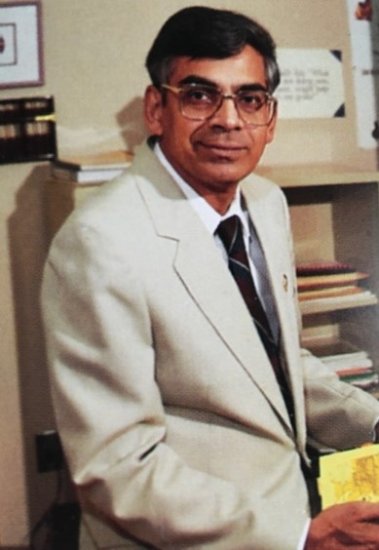Math tutor marks 5 decades at AU
Dr. Ved Madan’s history with Athabasca University goes back to its first course in 1970

Some educators have a passion for their work that truly goes above and beyond, driving them to continue that work well into their supposed retirement.
Dr. Ved Madan, a long-time tutor in Athabasca University’s Faculty of Science and Technology, is one of those educators. After a brief stint tutoring at the university in the 1980s, he returned to the role in 2000 and has worked with AU students ever since—a total of about 25 years.
“I will be 80 in June [2022], and I’m still working for my mental health,” he said. “And of course, my love for students.”
A tutor’s role is similar to that of sessional instructors at traditional universities: it involves working as an educator, but not necessarily doing research as part of their formal role. For many AU courses, the tutor is the main point of contact for students.
But while AU tutors share Madan’s passion for education, not all can claim the same intimate knowledge and understanding of AU’s history. He has worked as a tutor for about 25 years, but his history with the university goes right back to its origins in 1970—well before the internet helped to transform distance learning into what it is today.
“I will be 80 in June [2022], and I’m still working for my mental health. And of course, my love for students.”
– Dr. Ved Madan, mathematics tutor, Athabasca University
Distance education in the 1970s
After completing his PhD in applied mathematics from the University of Toronto in 1968 and then post-doctoral work at the University of Alberta in 1970, Madan joined Red Deer College in a teaching role.
He had heard about Biology 201: World Ecology, the first course at AU co-authored by the late Dr. Trilochan S. Bakshi, and decided to try it out. He enjoyed the experience, and took several other courses in computer science to better understand how computers could be used in his applied math work.
But the experience of an AU student in the 1970s was very different than what it is now. For one thing it required a great deal of patience, but he described the feeling of excitement when a new package came in the mail.
“The lessons would come on tapes, and we would have a tape recorder at home to hear the lecture,” Madan said. “Other paper material came by postal mail, and when we did the assignment, we had to send it back to the professor by the postal mail.”
His appreciation for distance learning as a student led him to apply for a job as a tutor at AU. He was successful and held that role from 1986-89 before moving on to other academic opportunities.
He recalled that the tutor role was in some ways quite different from what it is now, but the flexibility online education provided—both for students and for instructors—was apparent even in those days. For example, he described taking a stack of exams to mark with him on a flight to India, doing the work on the plane, and mailing the marked exams back to Canada upon his arrival.
“The lessons would come on tapes, and we would have a tape recorder at home to hear the lecture. Other paper material came by postal mail, and when we did the assignment, we had to send it back to the professor by the postal mail.”
– Dr. Ved Madan
Becoming an online educator
Madan’s academic roles took him to Red Deer College, the University of Western Ontario, Indiana University, and St. Mary’s University College. He formally retired in 1997 and moved to Calgary as his children were going to study at the University of Calgary.
Despite a long and successful academic career as an educator—and as a researcher publishing more than 50 articles in peer-reviewed journals—he was driven to continue teaching even in his retirement.
He returned to his position as a tutor at AU in 2000, and he still holds that role. Yet even in the past 20 years, the style and structure of distance learning has changed significantly. The online aspect of the Athabasca University experience was still in its early stages, but as it became the standard way to deliver courses, he maintained his passion for supporting students.
Madan explained that the role goes far beyond simply marking exams. Tutors serve as the main point of contact for students looking for support in their courses, and also liaise with the course coordinator to help refine courses and provide additional feedback. He said he works with about 150 students each month as the tutor for introductory calculus courses.
He said he has no plans to stop doing this work any time soon, either. His daughter, now a prominent Calgary physician who specializes in geriatric care, actively encourages it as a way to keep his mind active and prevent memory loss.
“I really enjoy my interactions with students at Athabasca University, giving them much hope for advancement,” he said.